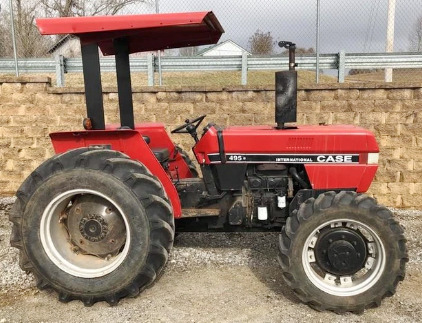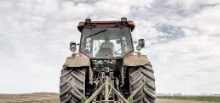________________________________________________________________________________________
| Home / Farm Tractors / Case IH Tractors / Case IH 495 |
Case IH 495 Troubleshooting
 The
Case IH 495 is a 2WD/4WD utility tractor from 95-series. The model was
manufactured between 1991 and 1994. The Case IH 495 tractor is powered by 179
cubic inches (2.9 L) Case D179 four cycle three-cylinder liquid-cooled diesel
engine with a rated power of 53 Hp (39.5 kW) and 182 Nm (134.2 lb-ft) of peak
torque at 1400 rpm.
The
Case IH 495 is a 2WD/4WD utility tractor from 95-series. The model was
manufactured between 1991 and 1994. The Case IH 495 tractor is powered by 179
cubic inches (2.9 L) Case D179 four cycle three-cylinder liquid-cooled diesel
engine with a rated power of 53 Hp (39.5 kW) and 182 Nm (134.2 lb-ft) of peak
torque at 1400 rpm.
The Case IH 495 was fitted with two types of transmission. Type 1: 8x4 partially synchronized transmission. Type 2: 16x8 partial power shift transmission. The max forward speed - 15,6 mph (25,1 kph), max reverse speed - 4.9 mph (7.8 kph).
The open center hydraulic system used a gear pump with fluid flow rate of 15.6 gpm (59.2 lpm). The rear lift capacity is 2340 lbs (1060 kg). The Case IH 495 was equipped with 6.00x16 front tires and 14.9x24 rear tires. The wheelbase is 79,8 in (2025 mm). The tractor is compatible with Case 2250 front end loader. The loader has a lift capacity to full height of 2500 lbs (1135 kg) and breakout force of 3500 lbs (1587 kg).
| Engine Troubleshooting |
| Diesel hard to start or doesn't start |
Air in the fuel system - Air bleeding.
Fuel filter element is dirty - Replace the filter element.
Dirty or faulty injection nozzles - Replace injection nozzles.
Water in the fuel system - Change fuel and repair fuel system.
The valve clearance is incorrect - Check and adjust.
Fuel injection pump malfunctioning - Replace or repair injection pump.
| Engine starts but immediately stalls |
Air filter element clogged - Install new air filter element.
Fuel filter element clogging - Service the filter.
Fuel injection pump leakage - Check the fuel injection pump for leaks and fix it.
Fuel injectors are dirty or defective - Replace or clean fuel injectors.
Faulty fuel injection pump - Replacement or repair required.
| Engine shuts off suddenly while running |
Engine is not warmed up to the required temperature - Warm up engine as required.
Fuel filter element is clogged - Service the filter.
Air in fuel tank - Bleed fuel tank.
Clogged or burnt injection nozzle - Clean or change injection nozzles.
Fuel injection pump timing is not adjusted - Adjust according to specifications.
| Engine stalling at idle |
Incorrectly adjusted low idle speed - Correct low idle settings.
Fuel injection pump failure - Change or repair the pump.
Defective fuel injectors - Replace or clean fuel injectors.
Excessive valve clearance - Correct valve clearance.
| Engine power is too low |
Clogged air cleaner - Carry out maintenance on air filter.
Fuel injection nozzles are dirty or defective - Clean or replace injection nozzles.
Incorrect fuel injection pressure - Test fuel injection pressure and adjust it correctly.
The valve clearance is not adjusted - Check and adjust.
Low idle speed setting is not correct - Correct low idle adjustment.
Fuel hoses or lines are clogged - Clean fuel lines and hoses.
Cylinder head gasket is worn - Cylinder-head gasket replacement required.
Piston rings are worn or defective - Install new piston rings.
| Engine overheating |
Coolant level is low - Fill radiator to proper level and check components for faults.
Engine oil level low - Check oil level and add oil as required.
Dirty radiator fins or defective radiator cap - Clean radiator or replace cap.
Excessive wear of the fan belt - Belt replacement is recommended.
Engine is running overloaded - Load reducing required.
| Oil pressure is insufficient |
Engine oil insufficient - Fill up the engine oil.
Oil filter clogging - Service or replace engine oil filter.
Improper type of engine oil - Use proper viscosity oil.
Incorrect oil clearance in crankshaft bearing - Bearing needs to be changed.
Defective oil pump - Install a new pump.
| Engine noises or knocks |
Engine oil level is insufficient - Fill up the oil to required level.
Engine not warmed up - Warm up to required temperature.
Improper fuel injection timing - Use the correct fuel injection pump timing adjustment.
Incorrectly set low idle speed - Correct the settings.
Damaged or clogged injectors - Change or clean fuel injectors.
Connecting rod is worn or not aligned - Need to align or replace the connecting rod.
Worn or scored pistons - Pistons replacement required.
| Transmission Troubleshooting |
| Transmission oil pressure is low |
Lack of transmission fluid - Check and refill the transmission fluid.
Clogged transmission oil filter element (if fitted) - Clean or change transmission oil filter.
Relief valve failure - Replace the valve.
| Transmission noises |
Insufficient transmission oil - Check transmission oil level and add oil as required.
Transmission fluid contamination - Fill up with fresh transmission fluid.
Gears are damaged or backlash is incorrect - Replace gears or adjust backlash correctly.
Bearings are cracked or worn - Bearings replacement required.
Worn or bent shift forks - Shift forks need to be changed.
Stuck or worn shaft splines - Replace the shaft.
| Hard to shift gears |
Gear shift linkage is worn or rusty - Install new shift linkage.
Shift forks are worn or bent - Replace the shift forks.
Defective parts in the gearshift mechanism - Replace defective parts.
Worn or unadjusted clutch - Adjust or change the clutch.
| Transmission fluid leaks |
Transmission fluid level is high - Correct the fluid level.
Broken seals or gaskets - Install new seal or gaskets.
| Hydraulics Troubleshooting |
| Hydraulic oil pressure is insufficient |
Low hydraulic oil level - Fill the system to proper hydraulic oil level.
Clogged hydraulic fluid filter element - Replace filter element or clean if required.
Faulty hydraulic pump - Repair or replace hydraulic oil pump.
Hydraulic control valve block is set improperly - Set properly.
Hydraulic cylinder is defective - Repair or install a new hydraulic cylinder.
Leaking hydraulic pipes - Inspect the system for leaks and fix it.
| Hydraulic system overheats |
Faulty main relief valve - Relief valve need to be replaced.
Wrong type of hydraulic fluid - Fill up with the correct type of hydraulic fluid.
Contaminated hydraulic fluid - Change hydraulic fluid.
Air trapped in hydraulic system - Bleed air from system.
| Hitch not lifting or hitch lifts slowly |
Excessive loading on the hitch - Reduce hitch load.
Hydraulic fluid level low - Fill up the hydraulic fluid.
Clogged hydraulic fluid filter - Replace filter element or clean if required.
Faulty hydraulic pump - Install a new hydraulic oil pump.
Damaged main relief valve - Relief valve need to be replaced.
Hydraulic spool valve is faulty - Repair or replace the valve.
Hydraulic cylinder not working - Change or repair hydraulic cylinder.
Disconnected or broken suction line - Change or connect properly.
| 3-point hitch won't lower or lowers slowly |
Incorrect setting hydraulic spool valve - Use the correct setting.
Broken hydraulic cylinder - Replace or repair hydraulic cylinder.
Misadjusted hitch - Adjust 3-point hitch as required.
Lift arm shaft is damaged - Replace the shaft.
| Hitch jerks when drop or lift |
Air in hydraulic pipes - Bleed hydraulic pipes.
Hydraulic oil is contaminated - Fill up with fresh hydraulic oil.
Hydraulic pump is defective - Replace or repair hydraulic fluid pump.
Damaged hydraulic control valve - Repair or replace the valve.
Defective hydraulic cylinder - Repair or replace hydraulic cylinder.
| Steering System Troubleshooting |
| Steering is difficult |
Improperly fitted or damaged steering column - Refit or change the steering column.
Air in steering hydraulic system - Bleed air from system.
Improper toe-in - Adjust toe-in wheels.
Uneven wear on front tires - Replace the tires.
Hydraulic steering pump is defective - Steering pump needs to be replaced or repaired.
Worn or stuck pump flow control valve - Clean or replace control valve.
Not enough steering fluid - Fill up steering fluid to required level.
| Excessive steering wheel play |
Worn steering column shaft or coupling - Replace defective part.
Defective hydraulic steering pump - Repair or replace steering pump.
Steering linkage assembly is worn or loose - Replace or repair steering linkage.
| Tractor is pulling to left or right |
Tires have uneven wear - Replace the tires.
Incorrect toe-in - Adjust toe-in properly.
Steering linkage joints are worn or loose - Inspect and change as required.
Damaged or improperly adjusted or worn front wheel bearings - Change or adjust bearings correctly.
| Electrical System Troubleshooting |
| Battery won’t charge |
Loose or corroded cable connections - Tighten or clean electrical wiring connections.
Electrical terminal connectors are defective - Terminal connectors should be replaced.
Battery is worn - Use a new battery.
Loose or worn belt - Belt needs to be adjusted or changed.
| Starter turns slowly |
Battery power is low - Recharge the battery.
Battery discharges quickly - Service or change the battery.
Faulty battery terminals or disconnected cables - Check battery wires and service or replace terminals.
| Starter will not crank |
Battery is discharged or defective - Need to charge or replace the battery.
Wiring is incorrectly connected or disconnected - Inspect wiring and connect correctly.
Low battery output voltage - Battery is drained, charge it.
Faulty starter motor - Repair or replace starter.
________________________________________________________________________________________
________________________________________________________________________________________
| Farm Tractors Technical Specifications |
